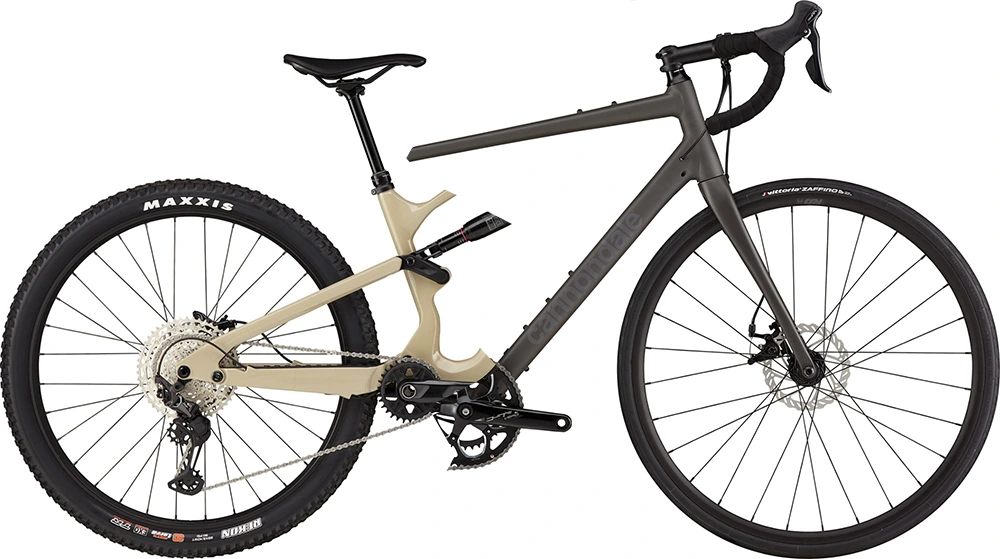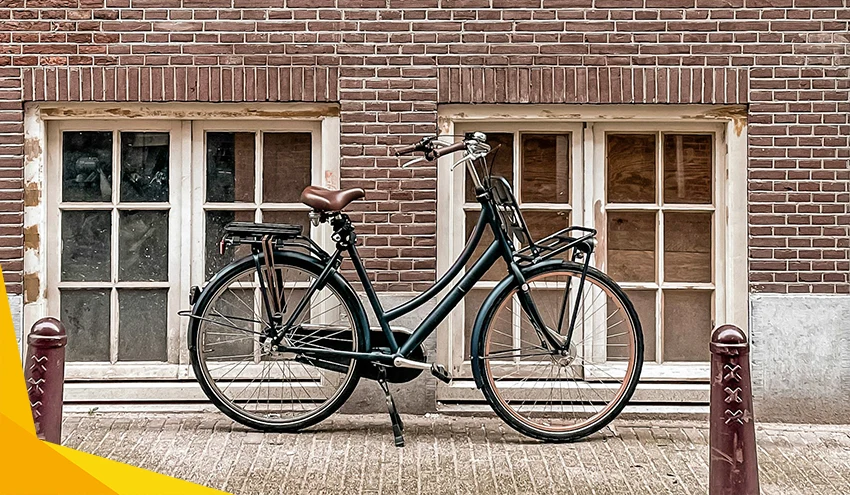Road bikes and mountain bikes are two of the most popular bike styles in the world. Gravel bikes aren’t far behind, which isn’t surprising because it’s basically a combination between a road bike and a mountain bike.
Designed for smooth road riding, road bikes are the style that we see in professional cycling, racing up and down the Alps and sprinting along the Champs-Élysées.
These bikes are fast, lightweight, and aerodynamic, the well-rounded speed machine in the world of bicycles.
Mountain bikes are the heavy and bulky frames that we see flying down the mountain in a Downhill World Cup race.
With performance-driven suspension and extra-wide tires, these bikes can handle the gnarliest of terrain, as well as your local mountain bike trails.
There are many different styles of mountain bikes, a few of which we will cover in this article.
But first, let’s answer the question: What is a mountain bike?
Mountain Bikes
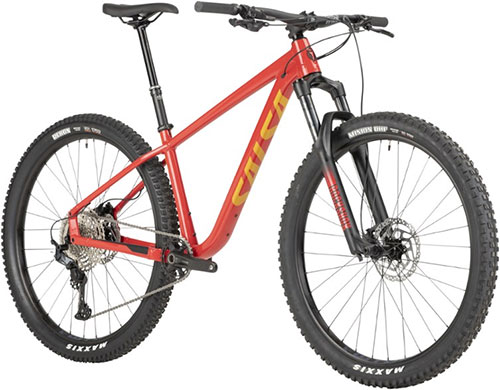
Mountain bikes are designed to be off-road bikes, it’s as simple as that. So many other bike styles try to be both – on-road and off-road – including road bikes, gravel bikes, and even cyclocross bikes.
But mountain bikes are designed for off-road riding, with frame geometry, components, and features designed for exactly that.
There are many different types of mountain bikes, with the main two distinctions being hardtail and full suspension (FS).
This refers to the suspension system used on the bike. Hardtail bikes only use front suspension, full suspension uses both front and rear suspension.
Suspension is one of the distinguishing factors between a road bike and a mountain bike.
Mountain bikes are significantly heavier than road bikes, even lightweight mountain bike frames. They also have thick tires and deep treads that allow them to grip even on the roughest and slipperiest trails. But this also means that mountain bikes are extremely slow on the tarmac.
There aren’t many huge variations of mountain bikes such as a road mountain bike. The closest iteration of this would perhaps be the gravel bike which borrows characteristics from both road bikes and mountain bikes to create a fast and capable all-road bike.
See the Mountain Bike Selection on JensonUSA
Road Bikes
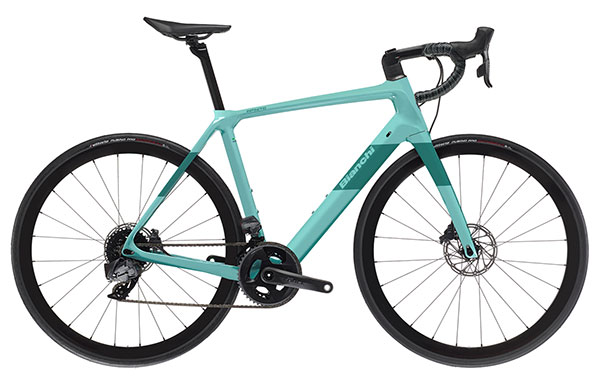
Road bikes are the opposite of mountain bikes in many ways, from their handlebar style and tires, to their (lack of) cushioning and overall purpose. As the name hints, road bikes are designed for road riding.
Whereas mountain bikes are suited for gnarly trails, road bikes are suited for smooth pavement.
When it comes to the road bike vs mountain bike discussion, road bikes are faster, lighter, and smoother overall.
Their frames are lightweight and aerodynamic compared to mountain bikes, as is the style of their drop handlebars.
Road bikes have smooth tires that are often half the width of a mountain bike tire. The grooves are so subtle that you sometimes need to squint to see them.
There aren’t as many different types of road bikes as there are types of mountain bikes. The main distinctions in are suspension and riding styles.
This all depends on how you classify a “road bike”. If we include hybrids, e-bikes, time trial bikes, and touring bikes, then there are many different types of “road bikes”.
Between traditional road bikes, perhaps the biggest differences are brake style and frame material.
Read Mode: Brakes Explained
Rim brakes have long been the road rider’s brake of choice, but disc brakes have taken off in the past couple of years and are now the go-to brake on most modern road bikes.
When it comes to the frame, there are two main choices for road bikes: carbon and aluminum. The former is lightweight and expensive, designed for elite cyclists and serious road riders.
Aluminum frames are a bit heavier, more robust, and cheaper than carbon frames, which makes them ideal for casual cyclists and first-time road bike buyers.
See the Road Bike Selection on JensonUSA
Differences Between Mountain Bikes and Road Bikes
Suspension

The biggest difference between a road and a mountain bike is the suspension or lack thereof. You will never find a suspension system on a road bike. The only bike close to it would be the basic suspension systems we see on some gravel bikes or hybrids.
It’s unsurprising, as road bikes are designed for pavement, which should never be so rough that you need suspension.
Plus, the suspension is heavy and slow, which is the last thing manufacturers want when designing a road bike.
Mountain bike suspension systems are plentiful and complicated.
As mentioned previously, the two main categories are hardtail (front suspension only) and full suspension (both front and rear suspension).
Hardtail mountain bikes are generally lighter and faster than FS mountain bikes. Hardtails are designed for light trail riding and cross-country mountain bike racing.
These suspension systems typically have 100-120mm of travel, which is the distance that the system can compress and therefore absorb shock from the trail.
FS mountain bikes include enduro mountain bikes, downhill mountain bikes, and freeride mountain bikes.
These suspension systems offer anywhere from 120-250mm of travel, which will allow you to ride the roughest and steepest trails, and even stick the landing over a 10m jump.
With their robust suspension systems, these bikes are typically quite heavy and slow anywhere that is not downhill.
For all-day mountain bike riding, cyclists typically choose the enduro mountain bike which is the FS closest to a hardtail mountain bike in weight and function.
Tires

Road bike tires are meant to be smooth and fast. That’s why they are significantly narrower than mountain bike tires. Road bike tires have very little grooving compared to a mountain bike tire’s hefty tread.
Measured in millimeters (mm), road bike tires range from 21mm to 38mm wide.
Most road cyclists choose a tire in the 28-32mm range. This provides the best combination of protection, grip, and weight compared to larger tires which can be heavy and slow.
Road bike tire pressure is pretty high (50-100psi) compared to mountain bike tire pressure which is kept at 20-35psi.
Learn more: Tire Pressure Explained
Measured in inches (in) rather than millimeters, mountain bike tires are significantly wider than road bike tires, and can often measure over 2 inches wide.
They also have a thick tread and knobby surface that is bumpy to the touch. Compared to the smooth road bike tires, mountain bike tires don’t look fast at all.
Instead, mountain bike tires are designed for holding grip in all sorts of off-road terrain. That includes rooted trails, muddy corners, and steep downhill sections.
A road bike tire would slide out in the first corner, whereas a mountain bike’s tire has the grip to take you all the way to the bottom.
Mountain bike tires are also thicker and heavier than road bike tires. In addition to being wider, mountain bike tires have puncture-protected sidewalls and thick treads to help avoid mechanical failures.
Read more: Bike Wheel Sizes Explained
Geometry
Road bike frames are much more compact than a mountain bike’s frame. It helps to achieve better aerodynamics which translates to faster speeds.
Mountain bike frames, on the other hand, are longer and more drawn out, which makes them more stable over bumpy terrain, and better handling on all sorts of trails.
Related: Men’s vs Women’s Bikes
Specifically, a road bike’s frame will have a longer reach and top tube compared to a mountain bike’s, and a different fork offset (i.e. fork ‘rake’) which is the distance between a straight line through the fork’s steerer tube and a vertical line through the front hub.
Road bikes have a shorter fork rake which leads to quicker handling compared to a mountain bike. This is better for road riding when your tire grip is much higher than a mountain bike’s on a slippery trail.
Mountain bike frames have a larker fork rake and slacker head tube angle which pushes the front wheel further out in front of the frame. This helps improve stability on steep descents and technical trails.
The shorter reach and top tube on a mountain bike helps improve handling, but it also puts the mountain bike rider in a much more upright position. This kills aerodynamics, but that is much less important on a mountain bike compared to a road bike.
Handlebars
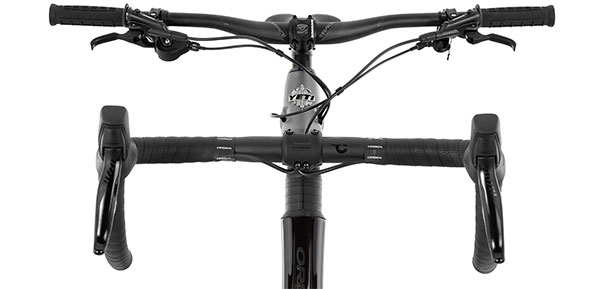
Handlebars are one of the biggest differences between a road bike and a mountain bike.
Handlebars completely change the cyclist’s position and control of the bike.
Road bikes have drop bars whereas mountain bikes have flat handlebars. Drop bars emphasize speed and aerodynamics. Mountain bike handlebars are there to give you better control over the bike.
Drop bars are the curved set of handlebars that we see at the Tour de France, and they offer three different and unique hand positions: hoods, tops, and drops.
In general, the hoods are used for general road riding, the tops are used for climbing or casual riding, and the drops are used for racing and sprinting. Each hand position changes the road rider’s body position and thus their overall aerodynamics.
Mountain bikes have flat bars, which are slightly curved handlebars that extend across the stem from left to right.
There is only one hand position for flat bars, and that’s on either side of the bar. So it’s no surprise that the shift and brake levers are located here, as well as the lever for a dropper post which is a mountain-bike-specific feature that allows the rider to raise or lower their seatpost at the push of a button.
Flat bars are significantly wider than drop bars, which helps improve bike handling and increase leverage. This makes flat bars best for steep descents and tight turns which you often find on mountain bike trails.
The reduced aerodynamics of flat bars are well worth the improved handling that they offer over a road bike’s drop bars.
FAQ
Is it bad to ride a mountain bike on the road?
It is completely acceptable to ride a mountain bike on the road, but be aware of the damage it could do to your tires.
For short pavement jaunts (a couple of miles in between mountain bike trails, for example), no significant damage will be done to your tires. And by damage, we mean the wearing out of the knobs that are so important to grippy mountain bike cornering.
Can you use a road bike for mountain biking?
No. With few exceptions (e.g. smooth, flat, and dirt mountain bike trails), road bikes are unequipped to handle mountain biking trails. You could do serious damage to your road bike on off-road surfaces, especially steep mountain bike descents, rock sections, and root-filled trails.
Are mountain bikes good for exercise?
Yes! Cycling is a great form of exercise no matter which bike you ride. You could be on a road bike, mountain bike, spin bike, recumbent, etc. and you will still get a great workout.
Compared to other bikes, mountain bikes will likely give you a better full-body workout because of the bumpy and technical trails. The balance, core, and upper body control that you need for mountain biking is much more demanding than other forms of cycling such as road riding.
Are road bikes good for exercise?
Yes! Again, cycling is a good form of exercise regardless of the bike you ride.
Road riding is typically smoother and more relaxed than other forms of cycling such as mountain biking or cyclocross, which means that road cycling is more of a pure legs and lungs workout than a full body one. Either way, cycling is a great form of exercise for your cardiovascular system, whether on the road or mountain bike trail.
Can you ride long distances on a mountain bike?
Yes, you can certainly long distances on a mountain bike. In fact, some of the longest and most challenging bike races in the world take place on a mountain bike. The Cape Epic, for example, is a multi-day mountain bike stage race held in South Africa where riders compete for over five hours a day on their mountain bike.
For everyday mountain biking, you can ride for 30 minutes or three hours, depending on your bike setup and trail networks. Most mountain bikes have adjustable suspension which means you can alter your setup between gnarly trails, bumpy roads, and flat pavement during long rides on the mountain bike.
Are road bikes good for beginners?
Yes, road bikes are great for beginners, especially modern road bikes with disc brakes and wide tire clearance. Road bikes give you lots of room for options and adjustability, which means that you can alter your setup based on your specific needs.
Disc brakes and wide tire clearance will help you stay comfortable and confident on the open road, and help cushion your ride over bumpy pavement.
Final Verdict
In the world of road bike vs mountain bike, there is no clear winner.
Both bikes are designed for completely different things, with the former being designed for fast road rides and the latter designed for technical off-road trails.
Amongst the most popular styles of bike, you could hardly make them more different than a road bike and a mountain bike. Unless you count a unicycle, those are quite different.
The differences between road bikes and mountain bikes are stark. They include everything from the frame and handlebars to the (lack of) suspension and tire style.
When choosing between the two, consider where you want to ride. Do you want to spend most of your time shredding through gnarly mountain bike trails, or sprinting against local legends on the area’s fastest road rides?
Your answer will tell you everything you need to know.

